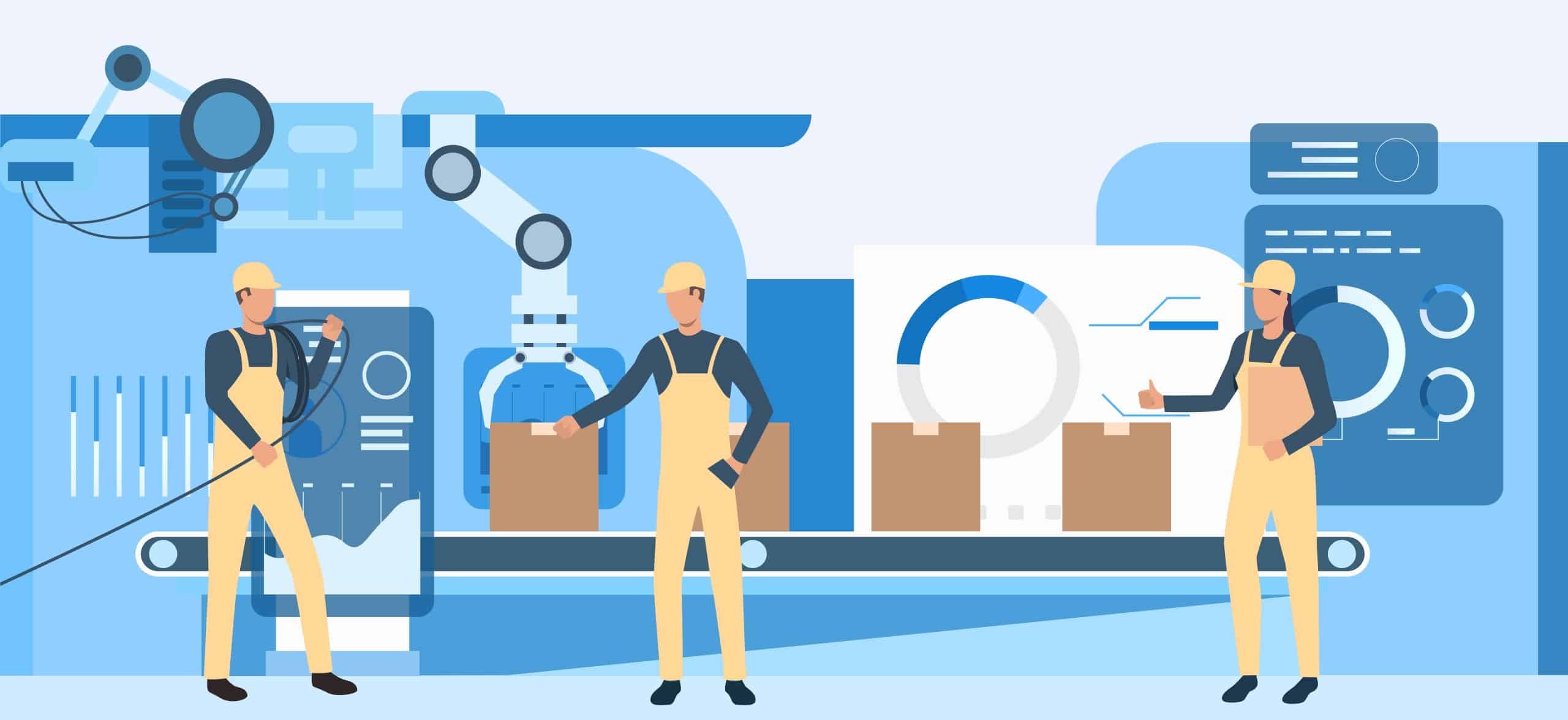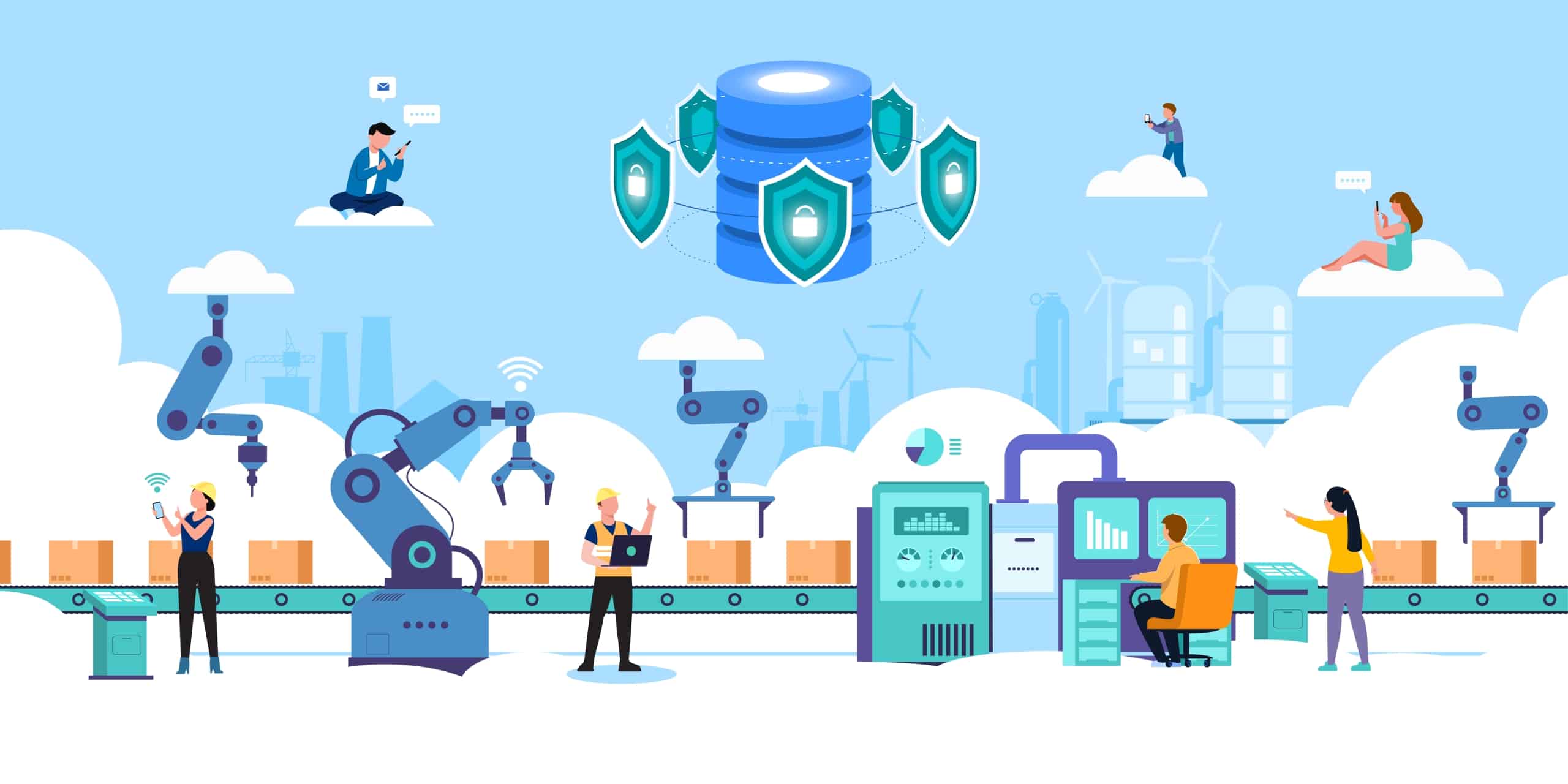Cutting-Edge Automation and Robotics
Automation and robots in wet wipes production significantly improve efficiency and uniformity. Automation technology in this industry involves advanced robots that can efficiently manage manufacturing processes with precision and control over quality and speed.
1. Robotic Accuracy and Velocity
Robotic solutions in wet wipes production are created to manage operations that were previously labor-intensive and susceptible to human mistakes. The activities include formulating washing solutions to precise specifications, cutting non-woven fabric to the correct sizes, and delicately folding wipes in preparation for packing. Robots’ accuracy guarantees that every wipe adheres to precise requirements for size, saturation, and fold, resulting in consistency across whole manufacturing batches.
2. Integration with manufacturing lines
Contemporary robotic arms are very versatile and can be easily incorporated into current manufacturing systems. The sensors and end effectors can adapt in real time to variations in material texture or moisture content, crucial for producing top-quality wet wipes. This versatility aids in sustaining a consistent and effective manufacturing process, reducing downtime, and optimizing output.
3. Improved Product Management and Packaging
Robotic technologies transform the handling and packaging phases of manufacturing. They can efficiently collect and package large quantities of wet wipes with delicate accuracy, minimizing the chances of product damage throughout the packing process. Robots can manipulate delicate materials without damaging the wipes because of advanced gripper technology. Robotics may be configured to accommodate different package designs and sizes, providing businesses with the ability to satisfy a wide range of market needs.
4. Integration of Quality Control
Automation and robots provide a notable benefit by incorporating quality control into the wet wipes manufacturing process. Robots with vision systems can thoroughly examine wet wipes throughout different manufacturing phases. These systems use cameras and other sensors to identify flaws or irregularities, such as uneven cuts or inadequate saturation levels, and have the capability to immediately discard faulty items. Real-time quality control guarantees that only items adhering to the highest standards are delivered to customers.
5. Scalability and Future Adaptations
Wet wipes manufacturers may achieve more scalability by using robotic systems compared to manual procedures while expanding production or adjusting to changing market trends. Robots may be easily modified and outfitted with various tools to handle new product kinds or revised requirements with little interruption. Flexibility is essential for maintaining competitiveness in a rapidly changing sector such as personal hygiene goods.
Ultimately, incorporating advanced automation and robots into wet wipes manufacturing aims to revolutionize the whole production process, not only enhance efficiency. Robotics are establishing new industry norms via accuracy, flexibility, and consistent quality, leading to creative and responsive production solutions.
Smart Manufacturing and IoT
Smart manufacturing and the Internet of Things (IoT) are transforming the manufacture of wet wipes by turning conventional factories into advanced and networked manufacturing centers. This transformation focuses on improving operational efficiency, implementing predictive maintenance, and managing production lines in real time to maximize output and maintain excellent product quality.
1. Real-time data collection and analysis
The use of IoT in wet wipes manufacturing includes a system of sensors and devices integrated into production machinery to gather and send data constantly. This data includes crucial factors for the manufacturing process, such as temperature, humidity, machine speed, and material input rates. Wet wipes manufacturers may get instant insights into their operations by examining this data in real-time, allowing them to detect any deviations from ideal production circumstances and take prompt remedial measures.
2. Anticipatory Maintenance and Minimization of Downtime
IoT in manufacturing is advantageous since it can forecast equipment breakdowns in advance. Sensors can identify abnormal vibrations, heat, or other signs of possible issues in equipment. Predictive analytics allows for maintenance to be scheduled proactively before equipment failure, leading to a substantial decrease in unexpected downtime. This proactive strategy not only prolongs the lifetime of equipment but also guarantees the uninterrupted and effective operation of manufacturing lines.
3. Improved Supply Chain and Inventory Control
The Internet of Things (IoT) is crucial for improving inventory management and supply chain logistics in the manufacture of wet wipes. Intelligent sensors can monitor the amounts of raw materials, updating inventory systems automatically and triggering orders when supplies are depleted. This high degree of automation guarantees uninterrupted production by preventing material shortages and contributes to maintaining an efficient supply chain, hence lowering storage expenses and waste.
4. Optimizing energy use and managing resources effectively
Intelligent manufacturing systems use the Internet of Things (IoT) to oversee and regulate energy use and resource consumption across the production area. Sensors can enhance the efficiency of power, water, and other resources by adjusting use according to current production requirements, therefore decreasing waste and cutting operating expenses. This not only promotes cost-effectiveness but also corresponds with wider environmental sustainability objectives, as wet wipes manufacturers want to reduce their ecological impact.
5. Personalization and Consumer Demand Reaction
IoT technology improves the adaptability of industrial processes, enabling rapid modifications to production lines to fulfill particular customer requirements. For example, if there is a sudden rise in demand for a certain kind of wet wipe, IoT systems may promptly modify the production settings to boost the production of that particular product. This capacity to respond quickly is essential in a consumer market that prioritizes both diversity and prompt availability.
6. Integration with corporate systems
IoT devices connect with larger organizational systems to provide a comprehensive perspective on operations outside the wet wipes manufacturing line. Information gathered from the manufacturing floor may be used for advanced analysis, such as evaluating overall company performance, strategizing for future expansion, and enhancing strategic decision-making. This integration guarantees that data-driven insights are used at all levels of the company, from the operational level to the executive level.
Smart manufacturing and IoT are revolutionizing the wet wipes business by enabling advanced monitoring, management, and optimization of production processes. The move towards linked and intelligent systems is establishing new standards for efficiency, quality, and responsiveness in production.
Advanced Materials and Eco-Friendly Solutions
The wet wipes sector is reacting to environmental concerns by researching sophisticated materials and implementing eco-friendly solutions. The advances address the increasing need for sustainability while also improving the performance and biodegradability of the items. Advancements in material science are changing the way wet wipes are made.
1. Biodegradable and compostable materials
A noteworthy trend in wet wipes production is the transition from conventional non-biodegradable materials such as polyester or polypropylene to natural fibers. Wet wipes manufacturers are now emphasizing substrates composed of plant-based fibers including cotton, bamboo, and cellulose, due to their renewability and biodegradability. Natural conditions facilitate the rapid decomposition of these materials, leading to a substantial decrease in environmental impact compared to manufactured alternatives.
2. Advancements in Fiber Technology
Cutting-edge technologies are used to improve the durability, ability to soak up liquid, and gentleness of natural fibers to suit the practical needs of wet wipes. Enhancing the hydrophilic properties of cellulose fibers by treatments may increase liquid retention and dispersion in wet wipes. Manufacturers may obtain a softer and more lasting wipe by altering the physical structure of bamboo fibers using mechanical or enzymatic techniques.
3. Water-efficient production methods
Producing wet wipes usually involves using large quantities of water, especially during the impregnation process when wipes are soaked with solutions. Advancements in industrial technology aim to decrease water consumption by using more efficient application methods, such as sophisticated spraying and impregnation systems that reduce waste and ensure maximum saturation. These technologies not only save water but also decrease the energy consumption linked to water treatment and recycling procedures.
4. Sustainable Chemicals and Formulations
In the move towards sustainability, there is a growing effort to use more natural and less toxic ingredients in wet wipes. This involves creating preservatives that do not include parabens, alcohols, or phenols, making them less irritating to the skin and more environmentally friendly. Organic and plant-derived components like aloe vera, chamomile, and tea tree oil are becoming popular in cleaning products, attracting environmentally aware customers.
5. Innovative Packaging
The environmental consequences of wet wipes go beyond the product and include its packaging. Wet wipes manufacturers are researching to provide packaging solutions that are recyclable, biodegradable, or manufactured from recycled materials. Efforts are being made to decrease the quantity of packaging used and enhance the effectiveness of packaging procedures to lower carbon footprints.
6. Certifications and Compliance
Wet wipes manufacturers are increasingly obtaining certifications like the Forest Stewardship Council (FSC) for utilizing sustainably produced fibers or the Biodegradable Products Institute (BPI) accreditation for compostability to support their eco-friendly claims. Adhering to these standards boosts customer confidence and ensures firms comply with global environmental legislation.
Developing materials and using eco-friendly solutions in wet wipes manufacture demonstrates a combined dedication to environmental responsibility and meeting customer preferences. Wet wipes manufacturers that invest in these areas are reducing the ecological effect of their goods and establishing themselves as leaders in a market that places importance on sustainability as well as usefulness. The trends are expected to continue developing, establishing new standards for the industry and providing a model for other industries seeking more environmentally friendly production methods.
AI-Driven Quality Control Systems
In the competitive and quality-conscious world of wet wipes manufacturing, AI-driven quality control solutions are increasingly critical. These solutions apply artificial intelligence to boost the accuracy, speed, and reliability of quality assurance processes, assuring that every product exceeds tight consumer and regulatory standards.
1. Automated Visual Inspection
One of the most successful applications of AI in quality control is via automated visual inspection systems. These wet wipes machines utilize high-resolution cameras linked with machine learning algorithms to verify wet wipes at various phases of the production process. AI algorithms are trained to spot flaws that would be unnoticeable to the human eye, such as small tears, incorrect cutting, uneven saturation, or contamination. By spotting these defects early in the production cycle, companies can minimize waste and ensure that only high-quality commodities reach the market.
2. Real-Time Data Processing
AI systems excel at processing and understanding massive volumes of data in real-time. In the context of wet wipes manufacturing, this capability offers continuous monitoring and analysis of the production parameters and the functioning of equipment. AI can spot patterns or anomalies that might flag prospective issues or opportunities for improvement, such as swings in moisture content, variances in size or thickness, and inconsistencies in the chemical composition of the washing solutions.
3. Predictive Maintenance
AI-driven quality control systems are tightly related to predictive maintenance technologies. By reviewing data from sensors monitoring equipment performance, AI can foresee when a wet wipes machine is likely to fail or when a component needs repair before these issues lead to product flaws. This predictive ability not only assists in maintaining continuous product quality but also boosts overall equipment effectiveness (OEE) and saves downtime in production.
4. Integration with Other Systems
AI quality control systems are typically coupled with other production management systems, such as enterprise resource planning (ERP) and manufacturing execution systems (MES). This connection permits a holistic approach to quality management, where data from the wet wipes production line may feed bigger operational decisions. For example, if an AI system detects a repeating issue with a certain batch of raw materials, it may trigger improvements in inventory or supply chain management to remedy the problem.
5. Quality Assurance Metrics and Reporting
AI systems may potentially automate the compilation of quality assurance reports and metrics. These reports offer extensive insights into the quality trends over time, the effectiveness of the quality control systems, and areas requiring improvement. By automating this reporting process, companies may ensure conformity with industry norms and standards, and promptly respond to changes in quality requirements.
6. Adaptive Learning and Improvement
Perhaps one of the most significant advantages of AI in quality control is its potential to learn and adapt over time. As AI systems examine more data, they gain better at spotting and anticipating quality difficulties. This continuous learning approach allows wet wipes manufacturers to constantly adapt their production procedures and boost product quality. The AI systems may also adjust to changes in wet wipes production processes, such as the introduction of new commodities or materials, without major reconfiguration.
AI-driven quality control systems are creating a new standard in the manufacturing of wet wipes. By leveraging the power of artificial intelligence, these systems give enterprises full capabilities to evaluate product quality, enhance operational efficiency, and adjust dynamically to production challenges. As technology improves, the role of AI in quality control is predicted to climb, allowing even more complicated solutions to match the rising demands of the market.
Challenges and Opportunities Ahead
The wet wipes market has a distinct set of possibilities and challenges as it adopts cutting-edge technology. The manufacturing industry is changing as a result of these advancements, which have the potential to significantly increase productivity and product quality. To address the challenges that come along with technical developments, they also need creativity and adaptability.
Challenges
- High Initial Expenditure Costs: Adopting cutting-edge technology necessitates a large initial capital expenditure. Examples include AI-driven QC systems, complex robots, and IoT infrastructure. Many wet wipes manufacturers find that the initial expenditures are a significant deterrent to adoption, especially small and medium-sized businesses.
- Skills Gap: As wet wipes manufacturing lines become more sophisticated technologically, so do the skills needed to run and maintain this new machinery. Workers with expertise in robots, data analysis, and software administration are in high demand in addition to conventional manufacturing skills. For wet wipes manufacturers, this skills mismatch may provide difficulties in hiring and onboarding new staff members.
- Complexity of Integration: It may be difficult and disruptive to integrate new technology with current systems. Wet wipes manufacturers must make sure that new wet wipes machines and software work with their existing wet wipes manufacturing processes. This may require significant system overhauls and downtime, which might have an impact on production.
- Data Security and Privacy: Wet wipes manufacturers need to handle the issues of data security and privacy in light of the growing usage of IoT devices and data-driven systems. With the increasing generation and storage of data, safeguarding sensitive data from cyber-attacks becomes more important.
- Regulatory Compliance: Regulatory compliance often fails to keep up with the rapid advancement of manufacturing technology. Wet wipes manufacturers have to deal with an ever-changing regulatory environment that varies greatly by area and addresses issues including labor standards, environmental effects, and product safety.
Opportunities
- Enhanced Manufacturing Efficiency and Product Quality: New technologies have the potential to significantly increase manufacturing efficiency and product quality. AI and automation may result in less waste, quicker turnaround times, and increased manufacturing accuracy, giving businesses a significant competitive edge.
- Market Expansion: Technologies such as IoT and robots enable producers to swiftly react to changing customer needs and explore new markets by boosting the scalability and flexibility of production lines. This flexibility may be especially helpful when reacting to trends and entering international markets.
- Sustainable Projects: Modern materials and environmentally friendly solutions provide producers a chance to lessen their influence on the environment and win over more and more customers who value sustainability. Over time, this change may result in cost savings from improved resource efficiency and adherence to environmental laws.
- Data-Driven Decision Making: Making better decisions is made possible by the abundance of data gathered from innovative industrial technology. Wet wipes manufacturers may save costs, enhance supply chain management, and optimize wet wipes manufacturing processes with the use of this data.
- Innovation and Product Creation: Using state-of-the-art technology promotes innovation in both product creation and the wet wipes manufacturing process. These technologies may be used by wet wipes manufacturers to develop new kinds of wet wipes with improved characteristics, such as integrated functions or better advantages for skin health.
The manufacturing of wet wipes is at an exciting phase of development, with unmatched potential for expansion and advancement offset by the difficulties of implementing new technology. Wet wipes manufacturers may redefine their position in the market by navigating these obstacles and reaping advantages that range from greater efficiency and product quality to extended market reach and sustainability. The future generation of wet wipes production will be shaped in large part by how well we embrace these technologies and deal with the associated issues.






